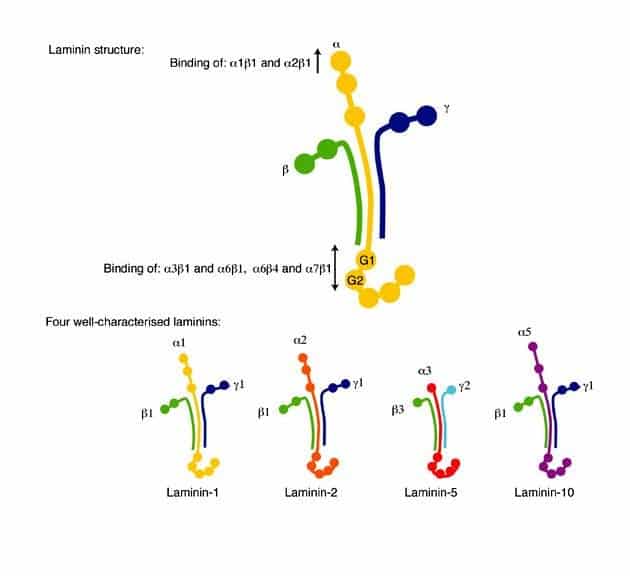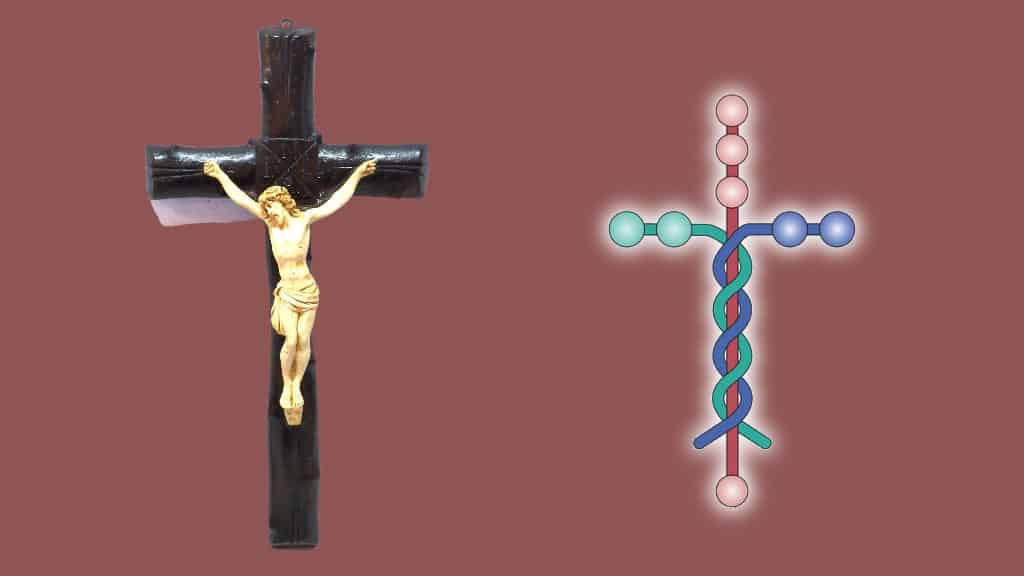Laminin, an essential protein for the cohesion of the body, exhibits a cross-like shape that has sparked reflections. While science confirms its structural role, some faith sectors emphasize the symbol of the cross. This article examines the debate and offers a balanced perspective, demonstrating how faith and science can coexist without conflict.
Laminin: A Molecular Foundation with Spiritual Symbolism
The complexity of the human body is evident in each of its cells, a vast and diverse assembly ranging from neurons to hepatocytes, not to mention all the elements that compose the total architecture of our organs. However, this cellular plurality could not maintain its order without the action of certain essential molecules.
Among these stands out a protein that, in the past decade, has generated extensive discussion beyond the scientific realm due to its peculiar structure: laminin.
This glycoprotein, considered a “glue” that holds the scaffolding of our tissues together, has been interpreted by some religious sectors as a sort of divine “signature” due to its cross-like shape.
The controversy surrounding laminin is not limited to science or theology. Rather, it places us at a juncture where fascination with biological complexity, theological analysis, and philosophical reflection can converge. Can a molecular discovery be symbolically understood as a spiritual emblem?
This question, potentially controversial, has become a point of convergence—or divergence—between the scientific community and certain segments of Christian faith. With a rigorous yet balanced approach, this article reviews the evidence, interpretations, and nuances of a debate that continues to generate interest in both laboratories and churches.
Laminin: An Essential Protein in Human Tissue
What is Laminin?
Laminin is a glycoprotein present in the basal lamina, the thin layer that lies between epithelial cells and the underlying connective tissue. It acts as a molecular bridge, linking cells to the extracellular matrix.
This biological “scaffold” not only provides stability but also regulates processes as important as cell differentiation, migration, and the growth of new tissues. In fact, at least twelve types of laminin have been identified in mammals, with variants differing in their structure, function, and distribution.

The most representative type, classic laminin (Type 1), is recognized for its characteristic configuration with three chains—alpha, beta, and gamma—that intertwine and extend into a cross-like shape. Images obtained through electron microscopy confirm this cruciform pattern, providing visual evidence for what was once merely a theoretical model.
Studies published in prestigious journals such as Nature and repositories like NCBI and Nature Portfolio detail these structures, outlining their importance in human physiology and pathology.
The Crucial Role of Laminin in Body Cohesion
Molecular biology specialists emphasize that laminin fulfills at least three essential roles:
- Structural Element: It functions as a solid foundation maintaining the body’s architecture, providing coherence to the cells that make up each organ.
- Cell Adhesion Mediator: It binds not only cells to one another but also cells to other extracellular components. This role is vital for forming and maintaining stable tissues.
- Regeneration and Growth Facilitator: By promoting cell differentiation, it stimulates the repair and proper development of damaged structures, contributing to the formation of new tissues.
In summary, laminin is a biological pillar that prevents the body from “collapsing” at the microscopic level. Without it, cellular cohesion would be severely compromised, making it difficult to maintain the integrity of each organ and, consequently, life itself.
The Symbolic Controversy: A Molecular Cross?
The Religious Interpretation: The Cross as a Unifying Symbol
A few years ago, a sermon by American evangelist Louie Giglio popularized the idea that laminin, with its cross-like shape, could be interpreted as a divine symbol embedded in human architecture.
This argument is based on the concept of laminin as a sort of “spiritual barcode,” a reminder of the cross of Christ, the foundation of Christian faith. For those who hold this perspective, the mere existence of this protein in the shape of a cross serves as a tangible metaphor for the unifying power of Jesus Christ and His central role in the reconciliation of all things.
The idea, undoubtedly appealing, spurred a wave of publications on biblical and scientific outreach websites, multiplying reflections on the convergence between faith and biology. From this perspective, laminin not only holds cells together but also evokes how Christ would hold His Church together: a kind of analogy between the human body and the spiritual body described in the Bible.
The Skeptical Response: Faith Does Not Need Molecular Confirmation
However, not all Christian believers or scientists share this enthusiasm. Critical voices point out that the Bible does not need molecular support to validate its truths. Traditional theology asserts that Christian faith existed long before the discovery of laminin and that Scripture is self-sufficient to communicate its principles without requiring biomolecular confirmations.
In the scientific field, some experts question the symbolic association, arguing that molecular representations are often simplified diagrams. They contend that the cross-like image is an idealized view, which can vary depending on how the protein is observed.
Furthermore, they remind us that multiple types of laminin exist, some with truncated or modified shapes, which relativizes the idea of a single “molecular cross.” According to these arguments, visual suggestion should not serve as a basis for inferring divine intention.
Evidence and Nuances: The True Shape of Laminin
Electron Microscopy and Structural Confirmation
Despite reservations, electron microscopy clearly confirms that classical laminin (type 1) possesses a cruciform shape.
Images obtained in various studies, some over three decades old, show the three-dimensional characterization of this molecule. The two short arms and the long main arm do not always appear at perfect angles, but the overall structure certainly resembles a cross.
Does this mean that laminin is a “divine seal”?
In the scientific field, conclusions must be based on verifiable and reproducible data, not symbolic interpretations. The cruciform shape is a functional advantage: it allows laminin to “extend its arms” to bind different cellular and extracellular components.
This particular geometry makes the consolidation of complex tissue networks possible, reinforcing the cohesion of the organism. In other words, the cross-like structure is functionally efficient and responds to evolutionary and biological criteria, rather than religious arguments.
The Presence of Variants and Molecular Diversity
The diversity of laminin types also adds nuance to the debate. While laminin type 1 exhibits a well-defined cross shape, others display slightly different configurations: some with shortened arms, others with elongated shapes, and even some lacking the upper end.
This diversity highlights that the “cross” is not an unchanging constant but one of the many structural manifestations that basal lamina glycoproteins can adopt.
However, the importance of laminin type 1 cannot be denied, as it is the most abundant, representative, and functionally essential. Its role in embryo formation, organ stabilization, and tissue consolidation is indisputable.
Therefore, while not all laminins are cruciform, the most relevant one is. This detail has been key for those seeking a spiritual analogy.
Theological Reflection: Science and Faith Without Collision
The Bible and Literary Figures
Christian theology has, for centuries, used literary figures and comparisons to illustrate complex truths. Parables, metaphors, and analogies abound in Scripture, helping to communicate deep messages to diverse audiences. If the apostle Paul used bodily analogies to explain the relationship between Christ and the Church, why couldn’t laminin be used as a contemporary pedagogical tool?
It is important to understand that the comparison is not meant to “prove” the Bible through scientific means, but to offer an evocative image that facilitates the understanding of Christ’s unifying work. In this way, laminin becomes a visual tool to appreciate a pre-existing spiritual truth, not the ultimate reason to believe.
Balance Between Scientific Admiration and Religious Conviction
The main contribution of this debate is to emphasize that science and faith can coexist without conflict. On one hand, science provides empirical data: it confirms the cruciform structure of laminin and details its essential functions in the body. On the other hand, faith offers symbolic interpretations that can enrich spiritual understanding.
The key is to maintain intellectual honesty. The shape of laminin does not, by itself, prove the veracity of Christianity, just as its presence does not contradict science. Rather, it evidences the inherent order of nature, something many religious traditions point to as the trace of an intelligent Creator.
The conclusion may be simple: faith does not depend on molecules, but scientific knowledge can deepen admiration for the Creator’s work if one chooses to interpret it that way.
Future Perspectives and Conclusions
As science progresses, it is likely that new functions of laminin or even other molecules with equally surprising geometries will be discovered.
Each discovery is a window into the complexity of the biological universe, a reminder that reality far exceeds our expectations. The current context, with an ever-growing base of scientific data available online, favors the verification of this information, providing greater transparency and credibility.
Sources such as the U.S. National Library of Medicine (NCBI) and the Journal of Cell Science are constantly expanding our understanding, offering peer-reviewed results that allow for the verification or refinement of interpretations.
An Invitation to Respectful Dialogue
Perhaps the most noteworthy value of this discussion is the opportunity to foster respectful dialogue. The controversy surrounding laminin and the cross becomes a useful pretext to raise deeper questions:
What role does faith play in a scientific world? What place does theology occupy when biology reveals minute details of our composition? These questions are not meant to generate conflict but to build bridges between different worldviews.
Ultimately, laminin, with its cross shape, serves as a metaphor to illustrate universal interconnectedness. It is a reminder that nature is full of patterns, and that the human mind seeks to interpret them based on its values, beliefs, and knowledge.
Are we witnessing a divine purpose or merely a beautiful molecular accident? The answer depends on each person’s perspective, and this plurality of views is, in itself, a richness.
Information courtesy of Ricardo Bravo Méndez – Professor of Biology and Science Education, 1987, University of Chile





